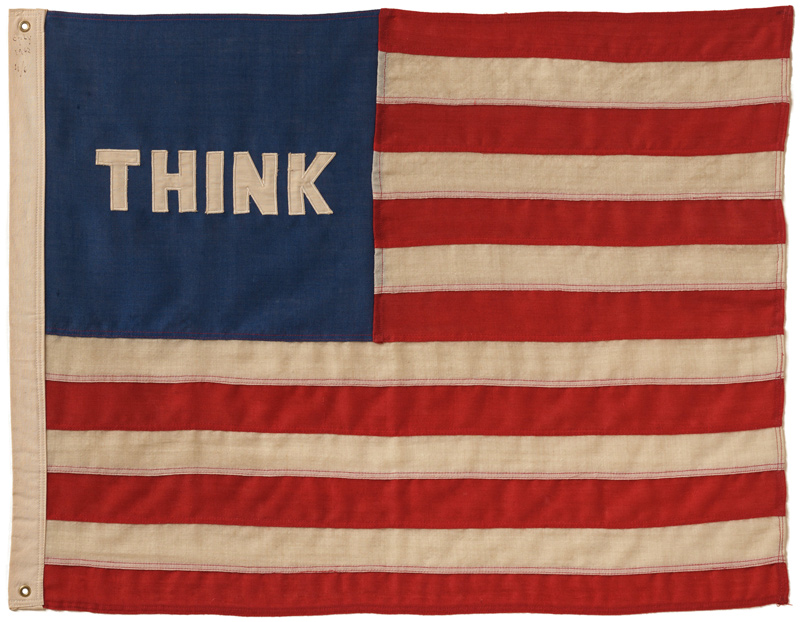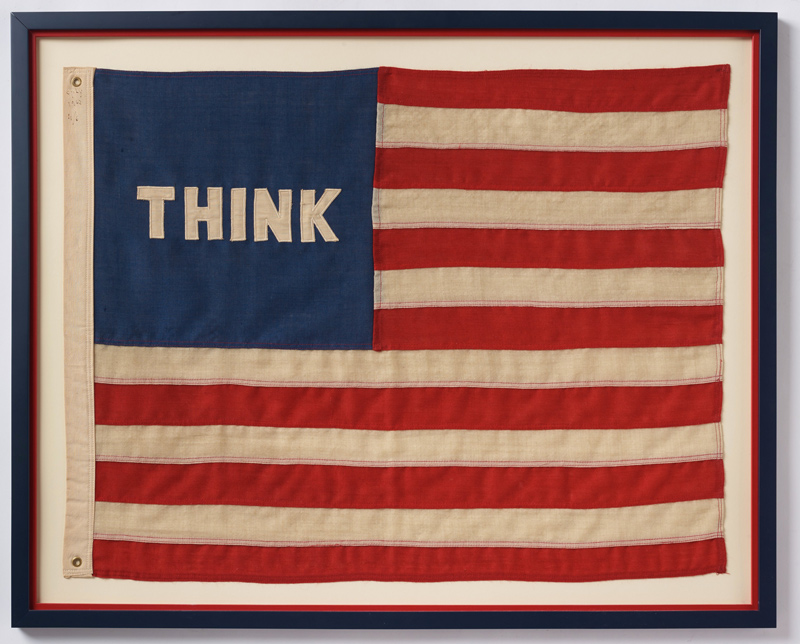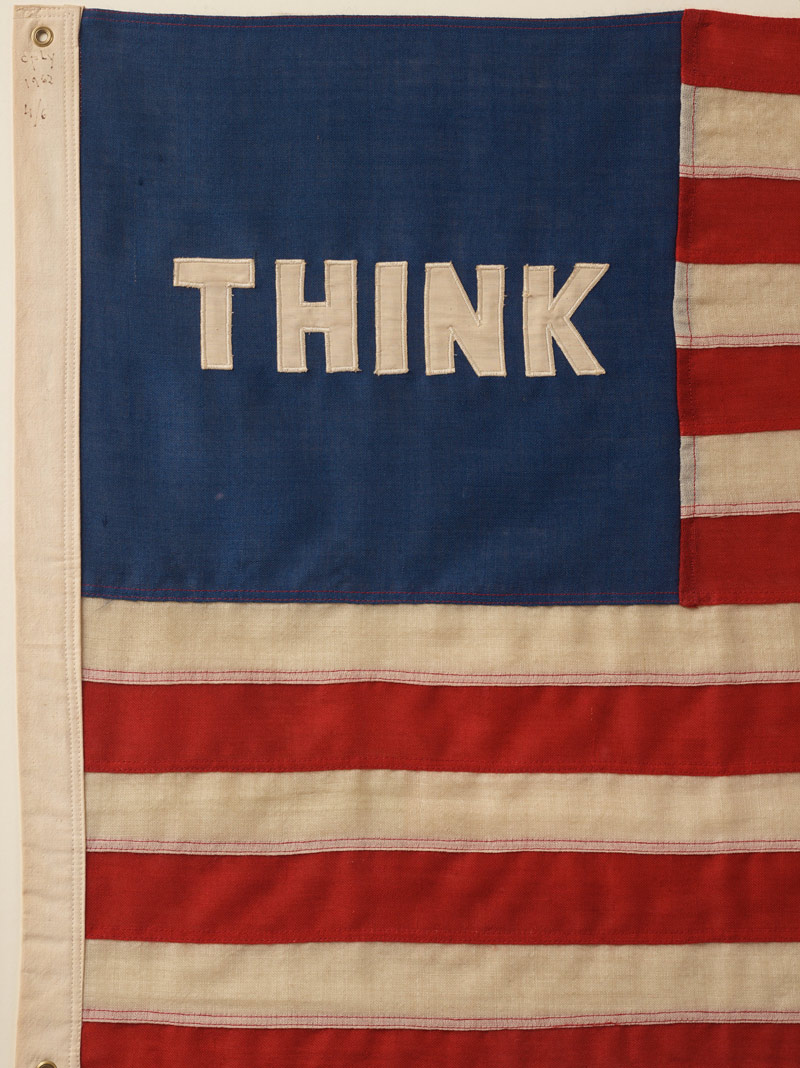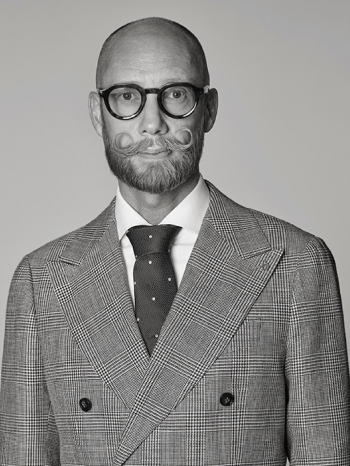Contemporary Art & Design presents Copley
› Signed CpLy and dated 1962 and numbered 4/6. Fabric and metal eyelets 65 x 84.5 cm. Bukowskis would like to thank the CPLY Archives/William N. Copley Estate for their assistance. Estimate 600 000 – 800 000 SEK.
William N. Copley
”Flag of the USA”
William N. Copley, also known as CPLY, was hugely important for art in Europe and the USA. He was a skilled artist but also a gallerist, writer, art patron, publisher and art advisor. He is seen as an important and unique link between European Surrealism and American Pop Art. He easily moved between both these genres and successfully brought them together in a very personal way.

Copley’s journey began in an orphanage in New York where he spent his first three years before being adopted by well-off parents. His adoptive father was a publicist and owned the newspaper conglomerate Copley Press. After boarding school and Yale, Copley was drafted into military service in Europe and North Africa during the Second World War. In 1945, Copley married his first wife, which brought him together with John Ployardt, who now became his brother-in-law. Ployardt was interested in art, which encouraged Copley to start painting himself. In 1948 they opened Los Angeles’ first gallery for Surrealist art. Following a successful meeting with Man Ray and later Marcel Duchamp, the gallery was able to host a total of six exhibitions by Surrealists such as René Magritte, Yves Tanguy, Joseph Cornell, Man Ray and Max Ernst. The exhibitions were spectacular, but sadly this was not reflected in sales and the gallery was forced to close in 1949. As Copley had promised all the artists that they would sell at least 10% of the works in each exhibition, he often ended up having to buy works himself in order to pay the artists. This is where William N. Copley’s renowned art collection came into being. When the gallery closed, Copley focused whole-heartedly on his own artistic career. His first exhibition was held in Los Angeles in 1951. That same year, he moved to Paris, with the eager encouragement of close friends such as Man Ray, Marcel Duchamp, Max Ernst and Dorothea Tanning. In Paris, he became an important part of the art community in Impasse Ronsin in Montparnasse. The district was an important location for Dadaists and Surrealists, and he had a studio there in the same alley as Yves Klein, Niki de Saint Phalle, Jean Tinguely and Constantin Brancusi.

In 1962, the same year in which he created the alternative American flag, Copley and his second wife moved to New York. By that time the start of the shift in which New York replaced Paris as the epicentre of innovative art had started. During this period, Copley created several works linked to Pop Art and works with political and satirical elements.
William N. Copley’s work “Flag for the USA” is one of his first works inspired by national flags, an important element in his art. The work is one of his very first sets of flags, created in 1962 in an edition of 6 different motifs. The suit arose in the turbulent period in which the USA found itself in the 1960s, with the Vietnam war, the Civil Rights Movement and race riots.
The Philadelphia Museum of Art has all nine flags in its collection. Besides Flag for the USA, Copley created flags for the following nations: Greece, the UK, Japan, Spain, France, Switzerland, the Soviet Union and Belgium. Ten years later, Copley once more took up his imaginative flags. In 1972, at Documenta 5, he presented a new edition entitled “Imaginary Flags”. This time, he created three new subjects (Egypt, China and Panama) and left out his earlier flags for Greece and Belgium. This meant that the 1972 edition included a total of ten flags.
William Copley’s first retrospective exhibition was held in 1966 at the Stedelijk Museum. The list of exhibitions that followed is extensive and practically includes all the major art institutions around the globe. For example, the Prada Foundation in Milan showed a William Copley retrospective in 2016.
His works are found in the collections of the Museum of Modern Art and the Whitney Museum of American Art in New York. Moderna Museet in Stockholm has this motif in its collection in the form of a black and white screen print produced by the artist in 1967.
To be sold at Contemporary Art & Design April 26
Viewing April 21 – 25, Berzelii Park 1, Stockholm
Open Weekdays 11 am – 6 pm, helger 11 am – 5 pm
Auction Live April 26, Arsenalsgatan 2, Stockholm
To the work

Condition reports & requests Contact specialist

Stockholm
Björn Extergren
Head of Consignment and Sales Department, Fine Art. Specialist Antique Furniture, Decorative Arts and Asian Ceramics
+46 (0)706 40 28 61

Stockholm
Louise Wrede
Specialist Contemporary Art, Private Sales
+46 (0)739 40 08 19

Stockholm
Karin Aringer
Specialist Photographs and Contemporary Art
+46 (0)702 63 70 57

























